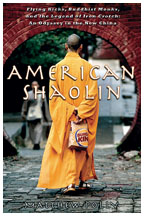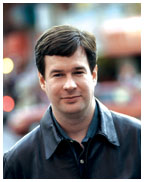April 18, 2007: Books and Arts
Reading Room
Transformation in China
Matthew Polly ’95 recounts his stint at a Buddhist temple
Dreaming of a new Globe in New
York
Theater project casts Barbara Romer ’93 in starring role
For a complete list of books received, click here.
Matthew Polly ’95 left college to study martial arts and Chinese at the Shaolin Temple in China. (courtesy Matthew Polly ’95) |
Reading
Room
Transformation
in China
Matthew Polly ’95 recounts his stint at a Buddhist temple
By Van Wallach ’80
 Growing
up in Topeka, Kan., Matthew Polly ’95 wrestled with self-doubt,
and even kept a list of “things that are wrong with Matt.”
The words “ignorant” and “cowardly” topped the
list. Attending Princeton eased his anxiety about ignorance, but he still
struggled with a vision of himself as gangly and weak, the kid others
liked to bully. As a freshman, he began taking kung fu lessons, which
led him to study Chinese culture and language at Princeton. Polly decided
the way to eliminate “cowardly” from his list was to “go
to the source” and study martial arts in China.
Growing
up in Topeka, Kan., Matthew Polly ’95 wrestled with self-doubt,
and even kept a list of “things that are wrong with Matt.”
The words “ignorant” and “cowardly” topped the
list. Attending Princeton eased his anxiety about ignorance, but he still
struggled with a vision of himself as gangly and weak, the kid others
liked to bully. As a freshman, he began taking kung fu lessons, which
led him to study Chinese culture and language at Princeton. Polly decided
the way to eliminate “cowardly” from his list was to “go
to the source” and study martial arts in China.
Despite opposition from his parents, Polly took a break from college and flew to China after his junior year. Relying on his rudimentary knowledge of Mandarin, he embarked upon two years of honing his language and martial-arts skills at the Shaolin Temple in Henan Province, the home of Zen Buddhism and kung fu. After getting kicked, flipped, pummeled, and, ultimately, celebrated for his abilities, Polly — self-doubt gone —returned to Princeton.
Polly’s book, American Shaolin: Flying Kicks, Buddhist Monks, and the Legend of Iron Crotch: An Odyssey in the New China, is a raucous, wry look at his transformation from a “weakling” to a fighting machine. Despite his lonely status as the only English speaker at his academy, Polly persisted in the training and language study so that after a year, he says, “I began to understand the culture. The people let me in.” Published by Gotham Books in February, the book recounts his picaresque adventures as he traveled, clashed with Communist Party functionaries, and switched from kung fu to kickboxing.
Training could be brutal. Polly describes his seven-hour-a-day regimen in a way that is painful even to read. After his first day, he writes, “It took me 10 minutes to get out of bed. I had to lift my legs with my hands to swing them over the edge. To stand, I had to rock back and forth.”
Back at Princeton after two years, Polly, a religion major, wrote his thesis on the Shaolin Temple and won a Rhodes scholarship. At Oxford, he studied in the politics, philosophy, and economics program. When he returned to the United States, Polly wrote for kung fu magazines, Playboy, and other publications, and he has done travel writing for the online magazine Slate. For years, he regaled friends with tales of China, so much so that an editor urged him to work the material into a book.
Reflecting a decade later, Polly finds his China experience a great influence on his life. He found, for example, that his China sojourn “reinforced my own background. You can be interested in other cultures, but the way you were raised is an anchor. I felt more Catholic and American and Kansan there.”
He still keeps a to-do list in his head. Princeton and China eliminated
some matters, but others remain. He says, “I hope with the book
I can cross off ‘career’ and ‘money’ to a certain
extent.” ![]()
Van Wallach ’80 is a freelance writer in Stamford, Conn.
To see a video of Matt Polly’s training in China, visit his Web site at www.mattpolly.com.
For a complete list of books received, click here.
 Portrait of a Priestess: Women and Ritual in Ancient Greece —
Joan Breton Connelly ’76 (Princeton University Press). In this cultural
history of priestesses in the ancient Greek world, the author describes
how the women who assumed these religious roles worked and lived. She
explores the rituals they performed, the political power they wielded,
and the ways they were honored in death. An archaeologist, the author
is an associate professor of fine arts at New York University.
Portrait of a Priestess: Women and Ritual in Ancient Greece —
Joan Breton Connelly ’76 (Princeton University Press). In this cultural
history of priestesses in the ancient Greek world, the author describes
how the women who assumed these religious roles worked and lived. She
explores the rituals they performed, the political power they wielded,
and the ways they were honored in death. An archaeologist, the author
is an associate professor of fine arts at New York University.
 The Art of Revision in the Short Stories of V.S. Pritchett and William
Trevor —Jonathan Bloom ’82 (Palgrave Macmillan).
Drawing on manuscripts, notebooks, and correspondence, the author examines
how these two short-story writers created and revised their work. Bloom
explores their relationships with their editors and how the writers transformed
actual incidents and people into fiction. Bloom has taught English literature
at Oxford University and is working on an edition of the letters and diaries
of V.S. Pritchett.
The Art of Revision in the Short Stories of V.S. Pritchett and William
Trevor —Jonathan Bloom ’82 (Palgrave Macmillan).
Drawing on manuscripts, notebooks, and correspondence, the author examines
how these two short-story writers created and revised their work. Bloom
explores their relationships with their editors and how the writers transformed
actual incidents and people into fiction. Bloom has taught English literature
at Oxford University and is working on an edition of the letters and diaries
of V.S. Pritchett.
 Only a Promise of Happiness: The Place of Beauty in a World of Art
— Alexander Nehamas *71 (Princeton University Press). Modern art
and philosophy severed beauty’s connection to everyday objects and
ordinary human beings, praising beauty only when it was limited to great
works of art and wonders of nature. The author re-establishes the connections
between art and ordinary life and between beauty, passion, and desire.
Nehamas is a humanities professor at Princeton.
Only a Promise of Happiness: The Place of Beauty in a World of Art
— Alexander Nehamas *71 (Princeton University Press). Modern art
and philosophy severed beauty’s connection to everyday objects and
ordinary human beings, praising beauty only when it was limited to great
works of art and wonders of nature. The author re-establishes the connections
between art and ordinary life and between beauty, passion, and desire.
Nehamas is a humanities professor at Princeton.
By K.F.G.
For a complete list of books received, click here.
(Art © 2006 Andy Warhol Foundation/ARS. New York/ photo Bruce M. White) |
Andy Warhol’s 1964 “Brillo Box,” left, is among the 80 works of art, including paintings, prints, drawings, and sculpture, by leading figures of the American Pop Art movement featured in an exhibit at the Princeton University Art Museum. Other artists included in the exhibition, Pop Art at Princeton: Permanent and Promised, are Robert Indiana, Alex Katz, Roy Lichtenstein, Claes Oldenburg, and Tom Wesselmann. The exhibition runs through Aug. 12.
Barbara Romer ’93, at left, with hip-hop mogul Russell Simmons. Below, an artist’s rendering of the New Globe Theater, which Romer is working to make a reality.
Photo: Patrick Butler; rendering: Foster and Partners |
Dreaming
of a new Globe in New York
Theater project casts Barbara Romer ’93 in starring role
By Massie Ritsch ’98
Ten years ago, Barbara Romer ’93 stood at the foot of a London stage modeled after Shakespeare’s Globe Theatre and experienced Henry V as a “groundling” would have in Elizabethan times. “I kept thinking, what would this structure look like in the 21st century with contemporary architecture [and] modern technology?” she recalls.
With a Ph.D. in art history and a passion for theater that took root when she produced and acted in plays at Theatre Intime, Romer eventually quit her job as a management consultant in New York to focus fulltime on imagining “a new Globe for a new world.” She envisioned integrating a circular theater into the decaying military fortress, Castle Williams, built on Governors Island to guard New York Harbor during the War of 1812.
Quixotic endeavors like Romer’s make great plays, and if hers were dramatized, the Act I curtain-closer would be approaching. This summer the National Park Service is expected to issue a general plan for Governors Island. If the draft allows a theater within the old fort’s thick sandstone walls, then the curtain will rise on Act II — securing the necessary approvals and launching a capital campaign for the $123 million project. But if the Park Service rules out adapting Castle Williams for anything other than, say, a military-history museum, then Romer’s show most likely will close.
As currently conceived, the New Globe Theater (www.newglobe.org) would hold 800 seats plus standing room for 400 patrons paying no more than the cost of a movie ticket — 21st-century “groundlings.” Next to ticket prices, a lack of child care is what keeps many people away from the theater, Romer says, so there would be an education center where children might see a puppet version of the play their parents are watching.
Early reviews for Romer’s concept have been positive. Sen. Hillary Rodham Clinton and other New York politicians have expressed support. Prominent members of the city’s arts community have signed on, as have celebrities: playwright Tom Stoppard and actors Al Pacino, Susan Sarandon, and Sarah Jessica Parker, to name a few, and hip-hop mogul Russell Simmons. Princetonians also have helped out: Romer’s classmate, actor Mark Feuerstein ’93, and film director Eugene Jarecki ’91, who is documenting her crusade.
Romer likes to point out that there is precedent for adapting historic
military installations for new uses. Fort Wood in New York Harbor, also
employed during the War of 1812, receives more than 4 million tourists
a year. The attraction is not the fort, but a “huge French sculpture”
assembled there in 1885: the Statue of Liberty. ![]()
Massie Ritsch ’98 is the communications director for the Center for Responsive Politics in Washington, D.C.




